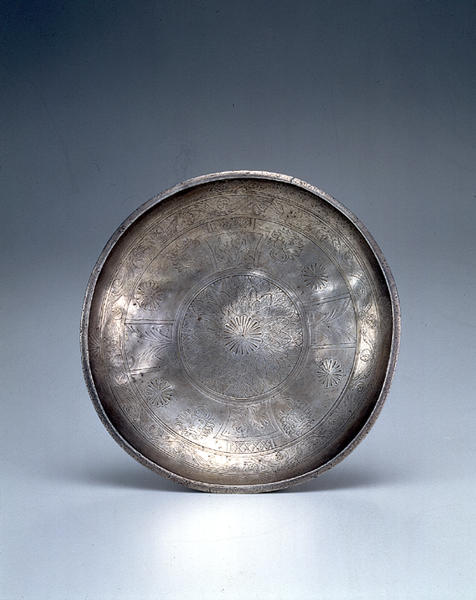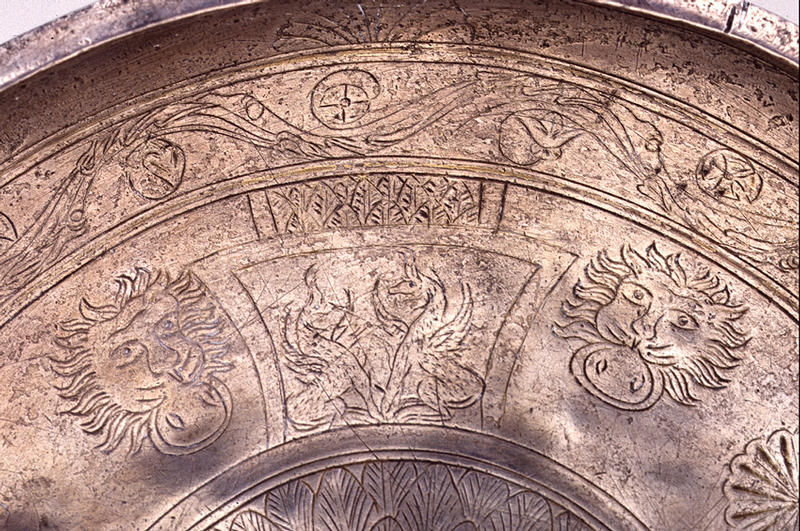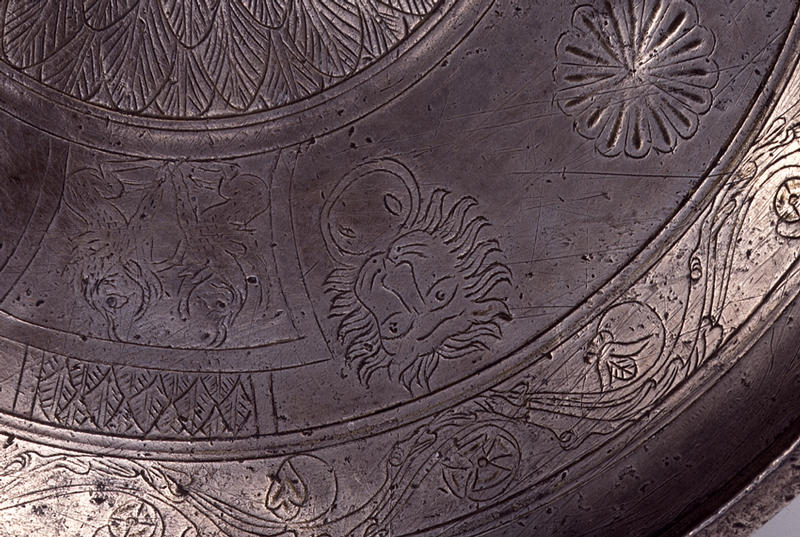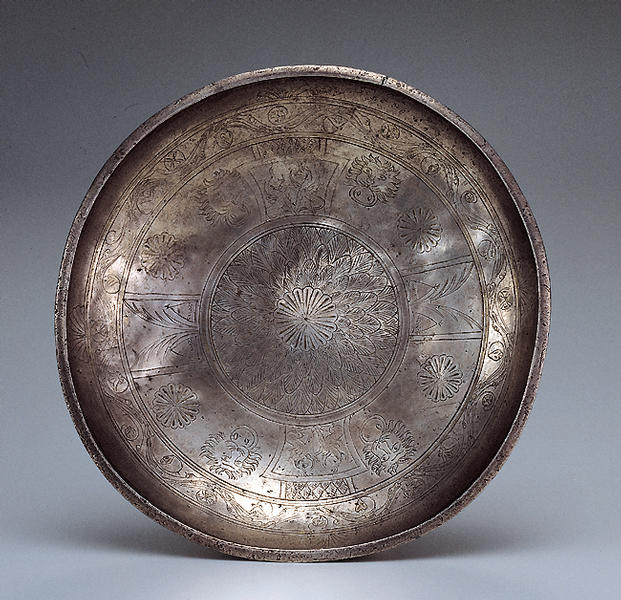Plate with Incised Design
- Afghanistan or Pakistan
- Late 2nd - early 1st century B.C.
- Gilded silver
- H-3.6 D-17.3
Catalogue Entry
This shallow plate ranks among the most striking examples of its class. It belongs to a group of Hellenistic silver, none of which has any recorded provenance or corroborated chronology but many of which have been sold as having a Near Eastern background.
The hammered silver plate is plain on the exterior and has been decorated on the interior by chasing and engraving and gilding. There is a flower tendril beneath the rim and an elaborate cross-like motif in the center. Rosettes and lion's heads supplement the central decoration. The surface is heavily worn and the original gilding is only preserved within the lines of decoration.
This is the first known plate of its type with an allusion to chronology and regional attribution. A motif appearing twice in the central cross--which depicts two pilei (cone-shaped caps worn by the dioscuroi) beside two palm branches-- is related to a motif that occurs on the reverse of a well-known coin type of the Indo-Greek kings Antalkidas (reigned about 145-35 B.C.) and Archebius (r. about 80-60 B.C.).1 Both monarchs ruled realms in present-day Afghanistan and Pakistan and represented the final generations of Alexander the Great's legacy of a Hellenized East.
Other aspects of the decoration can be compared with that on other examples. This is true not only for the scale pattern with a rosette in the center but especially for the bordering endless flower tendril, developed as a companion scroll with tiny spirals.2 Even the concept of a cross-like arrangement of rectangular fields and the enhancement of the cross positions by small pseudo-acanthus leaves beneath the rim over the tendrils may be compared in its basic design not only with some flowers in our tendril itself but with a familiar flower-and-leaf calyx pattern of Near Eastern Hellenistic silver.3 The use of the cross as a frame for figural scenery, however, is without known parallels.
The confronted animals with a raised forepaw in the other two sections of the central cross are reminiscent of Achaemenid compositions, but the outline of the wings strongly suggests a post-Achaemenid date.4 The winged and horned animals are somewhat difficult to classify, but probably represent griffins.
The small engraved lion's heads with rings in their jaws are curious. The general motif is apparently derived from Greek door handles, a detail heretofore unknown on an ancient plate, and was misunderstood by the craftsman, who omitted the lower jaws of the animals.
If we take this evidence literally, the Shumei plate should have been produced in the second half of the second or first half of the first century B.C. at the eastern frontiers of the Hellenistic world and at a time when Greek rule over the Indo-Greek territories would soon fade into history. Such an alleged atelier, remote and long separated from all the Greek and Near Eastern traditions, might explain the peculiar details. This chronological framework would fit very well with chronologies suggested for other plates of similar technique.
MP
1. Mitchiner 1975/76, vol. 2, p. 152, nos. 281, 282, with ills.; vol. 3, p. 211, no. 365, with ill.
2. For the system of the scroll see Pfrommer 1993, pp. 26-30.
3. For the Near Eastern cross see ibid. p. 32, fig. 28. For scale medallions ibid., p. 40.
4. For affronted Achaemenid sphinxes and other beings on seals see J. Boardman 1970b, pp. 34-36, pls. 1.5; 5.116-20; 6.135,138.
Catalogue Entry(Bac#032)
Late 2nd‐early 1st century B.C.
Gilded silver
H. 3.6 cm, Dia. 17.3 cm
This plate has an undecorated exterior and no feet, while its interior is incised. A central rosette is surrounded by a scale pattern medallion, and a frieze runs around the medallion, divided with an overall cross-shaped form. This band is then surrounded by a band with vining leaf patterns. The griffin-like designs facing each other in the middle of the cross-shaped frame seem to be a paired array of felt pilei caps shown between two palm fonds. This combination of palm frond and cap is iconography that can be found on the coins dating to the reign of Eucratides II (ca. 171-145 BC) who usurped the Greco-Bactrian 2nd century BC king Demetrius, and to the coins of Antialcidas (ca. 115-95 BC and Archebius (ca. 90-80 BC). Particularly, this back to back arrangement of palm fronds with leaves on only one side of their stems surrounding two caps can be seen on the coins of Antialcidas. While there are several known examples of Hellenistic metal ware incised with this type of Greek origin motif, elements such as the lion with ring handle and no jaw motif, the extremely simplified four petal rosette motif, and the vining pattern whose composition the artisan did not fully understand all seem to indicate that this work was created in a regional workshop somewhere in Central Asia.



